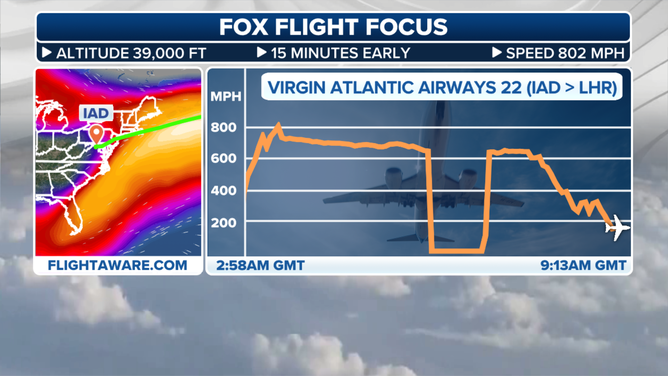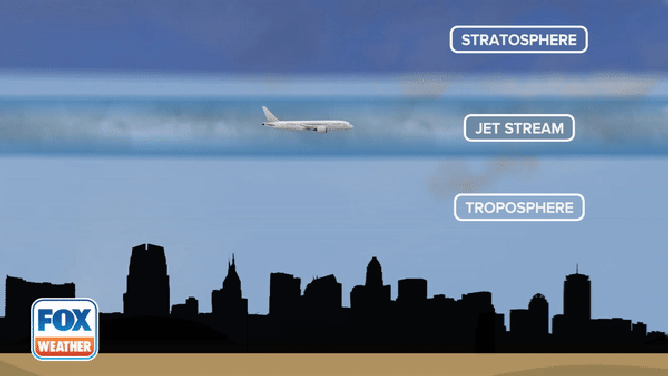Washington flights exceed 800 mph due to near-record winds over DC
Other air travelers also benefited from this powerful jet stream on Saturday and Sunday with commercial airline speeds reaching over 800 mph. Data from the NWS balloon near 35,000 feet shows upper-level winds peaked at 265 mph. Airplanes can ride this powerful tailwind while traveling east, reducing travel time.
US to UK flights topping 800 mph with near-record winds
Winds within the jet stream were measured topping out at 265 mph helping boost air travel times in the Mid-Atlantic on Sunday. Several flights from DC to London hit over 800 mph relative to ground speeds.
DULLES INTERNATIONAL AIRPORT, Virginia – Multiple flights from the DC area got a roaring start to London over the weekend with help from near-record jet stream winds over the Mid-Atlantic.
According to FlightAware, the flight from Washington Dulles International Airport (IAD) to London Heathrow International Airport (IAD) arrived 45 minutes early, and the wind and flight speed data can help explain why.
Travelers on Flight 22 can thank the powerful upper-level winds recorded at near-record speeds over the mid-Atlantic over the weekend.
The graphic below shows the equivalent ground speeds for Virgin Atlantic Airways flight 22 as it roared toward the Atlantic Ocean. The drop in data occurred because the plane was over the middle of the ocean.

Virgin Atlantic flight 22 speeds in mph.
(FOX Weather)
FlightAware data shows the plane hit a top speed of 802 mph relative to the ground when it was 33,350 feet in the air just over 20 minutes into the flight while it was still over the U.S. mid-Atlantic region.
HERE'S WHAT CAUSES TURBULENCE AND WHY YOU SHOULDN'T BE AFRAID OF IT
Other air travelers also benefited from this powerful jet stream on Sunday night, with speeds reaching over 800 mph.
British Airways flight 292 departed the gate at 9:56 p.m. on Sunday and arrived 32 minutes early at London Heathrow International. FlightAware data shows the jet reached a top speed of 806 mph less than 1 hour into the flight.
Yet another British Airways jet reached a top speed of 809 mph after flight 216 departed on Sunday at 6:38 p.m. and arrived at London Heathrow 20 minutes early on Monday, according to FlightAware.
The UK-bound flights were able to ride the powerful winds known as the jet stream. These winds in the upper levels of the atmosphere travel from west to east and form when warm air masses from the south collide with cold air masses from the north. And since that boundary between cold and warm air masses is more pronounced during winter, the jet stream is more robust during winter.

Commercial airlines usually fly between 5-9 miles above Earth's surface and can take advantage of a strong jet stream.
(FOX Weather)
The Baltimore-Washington National Weather Service office reported a weather balloon on Saturday evening detected the second-strongest upper-level wind in DC-area history, dating back to the mid-20th century.
Data from the balloon between 34,000-35,000 feet shows the wind peaked at 265 mph. This tailwind is what airplanes can ride while traveling east, reducing travel time. These records for the DC area date back to 1948.
"For those flying eastbound in this jet (stream), there will be quite a tailwind," the NWS wrote on X.
Did these commercial planes break the sound barrier?
While these planes were traveling incredibly fast, the airplanes did not break the sound barrier even though they all reached speeds over 767 mph.
FOX Weather Senior Meteorologist Jordan Overton explains this is because of something called airspeed.
"The ground speed, which we commonly measure, is the airplane speed plus the winds around it," Overton said. "Therefore, while the plane, relative to the ground, would be going 800 mph, the actual airspeed of the plane is lower, around 500 or 600."
The sound of a sonic boom happens when an aircraft or rocket breaks the sound barrier. In this case, the plane is going with the wind, not actually breaking the sound barrier.
